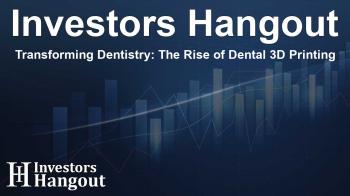Transforming Dentistry: The Rise of Dental 3D Printing

The Expanding Horizon of Dental 3D Printing
The global Dental 3D Printing Market is experiencing significant growth, with forecasts suggesting a remarkable rise in value from US$3.40 billion in 2024 to an astonishing US$10.06 billion by the end of the decade. This growth is driven by the adoption of advanced dental technologies that provide improved patient outcomes, including enhanced comfort and fit compared to traditional methods.
The Advantages of Dental 3D Printing
Through digital manufacturing, dental prosthetics such as crowns, bridges, and dentures are customized for better fitting. Notable advancements in applications, including custom surgical guides and implant-supported restorations, are making dental 3D printing further appealing. A surge in dental procedures, alongside various factors such as rising awareness about oral health and the benefits of dental 3D printing, is fueling the momentum in this market.
Challenges Facing the Market
While the growth potential is promising, there are challenges hindering the rapid expansion of dental 3D printing. Factors such as the high cost associated with 3D printing technology, side effects linked to dental anesthetics, and limited access to advanced technologies in some regions pose obstacles. Moreover, the need for considerable investment in training dental professionals and stringent product approval processes are also impactful. Despite these hurdles, ongoing modernization efforts and an aging population continue to drive increased demand for dental procedures, ensuring a bright outlook for the market.
Market Segmentation and Dynamics
The dental 3D printing market can be segmented into various categories: product & service, technology, application, end user, and geographic region. The technology segment includes methods such as VAT photopolymerization, fused deposition modeling, and selective laser sintering, with VAT photopolymerization leading in market share due to its precision and material versatility.
The Role of Dental Models in Modern Dentistry
In terms of applications, the production of dental models stands out as the most widely utilized segment in dental 3D printing. These models are indispensable in contemporary dentistry, aiding dentists in understanding individual patient needs better and creating tailored dental solutions. Incorporating digital tools such as CAD/CAM systems not only enhances the speed of model creation but also reduces costs, significantly transforming workflows within dental practices.
End Users Driving Market Innovations
The end-user segmentation reveals dental laboratories as the largest group in the dental 3D printing market. The rising demand for innovative technologies in cosmetic treatment and high-quality dental products is central to this trend. Dental laboratories are shifting towards 3D printing methodologies to fabricate a variety of items, benefiting from increased accuracy and operational efficiency that these technologies afford.
Regional Insights and Performance
Examining the regional dynamics, North America stands out as a leading region in dental 3D printing, bolstered by its developed healthcare system and a high level of technological adoption. The region’s market dominance is attributed to a demand for aesthetic dentistry and a substantial number of dental 3D printing companies located here.
Prominent Players in Dental 3D Printing
The dental 3D printing landscape is filled with competitive players, including Stratasys, 3D Systems, and Desktop Metal. These companies lead the charge through product innovation. Stratasys, for instance, is known for its wide array of biocompatible materials tailored for dental applications. Meanwhile, 3D Systems enhances its market share through acquisitions and comprehensive dental solutions, ensuring its position remains strong.
Conclusion: The Future of Dental 3D Printing
As the dental field continues to embrace digitalization, the future of 3D printing within dentistry looks extraordinarily bright. The advantages offered through innovative solutions promise to reshape dental treatments and elevate patient experiences significantly. Continual advancements in technology and increasing acceptance of 3D-printed solutions indicate that this market will not just grow, but thrive in the coming years.
Frequently Asked Questions
What is the projected value of the dental 3D printing market by 2030?
The dental 3D printing market is projected to reach US$10.06 billion by the year 2030.
What are the main drivers of growth in the dental 3D printing market?
Main drivers include rising oral diseases, increased awareness of dental technologies, and the demand for enhanced dental prosthetics.
How do dental models benefit patients?
Dental models help in accurately diagnosing conditions and tailoring treatments to individual patient needs.
What technologies are commonly used in dental 3D printing?
Popular technologies include VAT photopolymerization, fused deposition modeling, and selective laser sintering.
Who are the major players in the dental 3D printing market?
Major players include Stratasys, 3D Systems, and Desktop Metal, known for their innovative products and market leadership.
About The Author
Contact Lucas Young privately here. Or send an email with ATTN: Lucas Young as the subject to contact@investorshangout.com.
About Investors Hangout
Investors Hangout is a leading online stock forum for financial discussion and learning, offering a wide range of free tools and resources. It draws in traders of all levels, who exchange market knowledge, investigate trading tactics, and keep an eye on industry developments in real time. Featuring financial articles, stock message boards, quotes, charts, company profiles, and live news updates. Through cooperative learning and a wealth of informational resources, it helps users from novices creating their first portfolios to experts honing their techniques. Join Investors Hangout today: https://investorshangout.com/
The content of this article is based on factual, publicly available information and does not represent legal, financial, or investment advice. Investors Hangout does not offer financial advice, and the author is not a licensed financial advisor. Consult a qualified advisor before making any financial or investment decisions based on this article. This article should not be considered advice to purchase, sell, or hold any securities or other investments. If any of the material provided here is inaccurate, please contact us for corrections.

